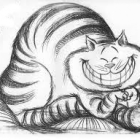 There are big things and small things in our world, and they work in different ways.
There are big things and small things in our world, and they work in different ways.
In the Big World are all the things that you can see around you, so these are the things we learn about first. Even as a baby, you begin to notice that some things are big and heavy and you have to try harder to push or lift them. You learn that if you are holding something up and let go, it will fall to the floor. We all grow up seeing and learning these things; we begin to think that everything is logical and natural and that we understand how things work in our world. These Big World observations are part of what scientists call “Newtonian Physics.”
However, there is also the Small World, which has things that are too small for us to see. It took people a long, long time to begin to understand the Small World. First they had to invent microscopes and telescopes and many other tools that scientists use. With the new tools people learned that everything is made of tiny things called atoms, and atoms are made of even smaller things called particles. The study of these teeny-tiny particles is called “Quantum Physics.”
The Big World and the Small World are not really separate; they are two parts of the one reality we all experience. They are divided this way only because this is the way humans have come to know them. Unless you are a scientist, you will probably never see the Small World and may forget about it entirely. But the science of the Small World will affect things you do, because it is now part of how we make computers and other tools.
As scientists studied atoms and particles, they came upon some very surprising information. For instance, bits of light sometimes showed up as particles and sometimes as waves, like the waves in the ocean. The scientists wondered how light could be both a particle and a wave.
Sometimes a particle will partner up with another particle. When scientists separate them, they find that changing a characteristic of one particle produces the same change at the same time in the other particle whether it is nearby or thousands of miles away. They called this “quantum entanglement.” Einstein called it “spooky action at a distance.”
Even more astonishing, scientists noticed that in the Small World light acts in different ways depending on whether or not something, a person or a machine, is watching how it behaves. It’s as if the light particles KNOW they are being watched. This was shocking and very hard for the scientists to believe, because in the Big World things without brains don’t KNOW anything. People and animals can know stuff, but things do not know anything because they don’t have brains.
Can everything in the Universe “know” things? Is the Universe made of knowingness or consciousness? Science cannot yet tell us, but it seems like a definite possibility.